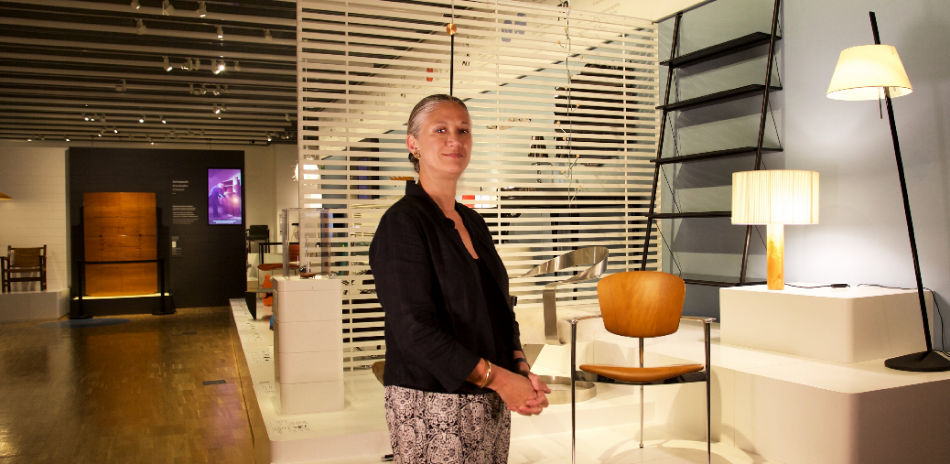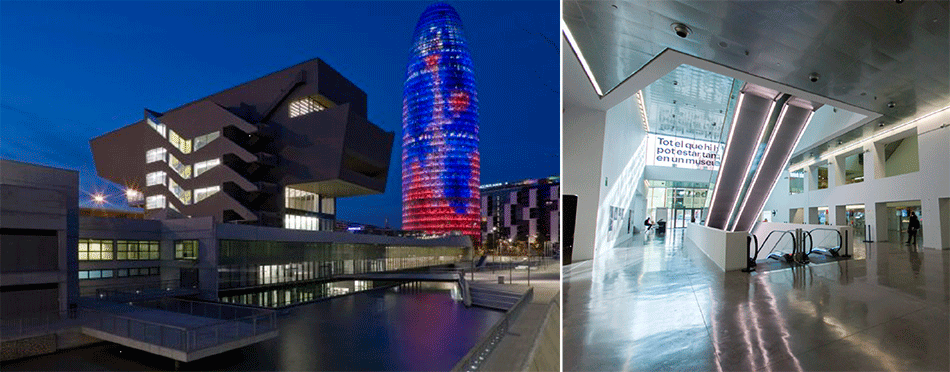
Pilar Vélez in the area of the museum dedicated to Product Design. The collection includes the best productions, the most relevant companies and most Catalan and Spanish artists since the 1930s. It is the first and only collection in Spain that holds such a variety. Pictures by Jordi Massó
Pilar Vélez has been entrusted with the huge task of starting and developing the Museo del Diseño de Barcelona, assembling four museums in one, in a new building specially designed for this purpose.
As well as assembling the art treasures of four important collections, Vélez is also in charge of the not less important task of projecting and consolidating the city of Barcelona as a world reference in design. Thus, Pilar holds a historic responsibility.
In our interview with Pilar, this task does not seem to bother her. She became director of the museum thanks to her prolonged and successful journey in “museum career”, and her encyclopedic knowledge of the issues she must handle.
“This is the city’s great museum of the arts of the object”, states Pilar with enthusiasm and emphasis, “with more than 70,000 objects. It is the result of including collections from the Museo de las Artes Decorativas (Museum of Decorative Arts), the Museo de Cerámica (Museum of Ceramics), the Museo Textil y de Indumentaria (Museum of Textiles and Clothing), and the Museo de las Artes Gráficas (Museum of Graphic Arts)”.
When we ask Pilar about the task of projecting today’s design, she answers: “For centuries, Barcelona and Catalonia have had a great heritage in the field of arts of object. In addition, the city has been a worldwide reference of design for years”. And we believe that with this new and spectacular platform, the knowledge of the talent of our designers and companies at an international level will increase.
We have frequently visited the museum in the last few weeks and we have seen the constant comings and goings of design professionals from around the world, attending the different events organized by the museum. Hence, it seems that this task is beginning to be successful.

Pilar Vélez in the area of the museum dedicated to Decorative Arts. This area exhibits unique pieces of art in the world, extremely rare and singular art.
When visiting the museum collections on historic objects, we can see the important artistic precedent of Barcelona: furniture, ceramics, glass, textile, metalwork, embroidery… a whole world of artistic expression converted into value and that, according to Pilar, “the city wanted to see again”. Therefore, the first effort has consisted in the great task of moving four museums and bringing them back to the city in a new museographic concept.
One of the areas of the museum that Pilar wants to place emphasis on is the presence of “Author-Centred Art”. “This artistic field is also included in the museum. Contemporary applied arts, with usually unique or with small production pieces of art, show a huge creativity in both techniques and forms inherited from the past but free from old servitude”, says Pilar.
In fact, the presence of ceramics by Picasso, Miró and other relevant artists -donated by the authors themselves- can be seen in the museum.
In a synthesis effort, Pilar tells us the purpose of gathering collections that may seem so different in time and techniques; “All these objects, past and current, have sense together under the same roof: they support each other, some objects help to explain others, they help to establish different connections in technology, sociology, history of art, history of design…”
In fact, the museum is a time exhibition in which we can discover how art transforms itself into something new each time (as an improvement or evolution), something that would not be so easy to see without this historic referent.
In this regard, Pilar summarizes what she believes is the key of the museum with the following motto; “from decorative arts to design, and to contemporary author-centred art”.
Therefore, despite owning a huge heritage of historic objects, the museum also gives strong support to the future. The museum dedicates important areas and activities to today’s design in all its different fields.
Pilar stresses the aim of the museum, “The museum wants to advance the future by following today’s design in all its different fields or the most sophisticated techniques”. “The museum is working to increase its national and international relationships, establishing agreements with other museums, design centers, universities and design companies, so as to work together and organize events such as workshops, conferences and congresses, research projects and the spreading of new improvements.”
In the museum’s exhibitions, Pilar will also introduce the concept of a flexible museography. “From a museographic point of view, we prefer to avoid the concept of a traditional long-standing permanent exhibition, because the present of a museum like ours requires higher dynamism, changing exhibitions and an easy access to a more plural knowledge.”
The museum has already given us the first signs of such dynamism. In the few months it has been opened, the museum has already organized many temporary exhibitions. Hence, after this first set in motion, we can expect new initiatives, very creative from a museographic point of view that will motivate us to frequently visit the museum. Pilar is not only thinking of this, but she is also working on this idea.
Not surprisingly, and with very good reason, Pilar states: “we currently live deep in a digital and virtual world, to witness the value of the object is more basic than ever.”
Pilar does not want to conclude this interview without three mentions of gratitude: firstly, to the patrons who have generously donated relevant objects and whole collections; secondly, to the promoter of what is now the new museum, a reality thanks to the vision of the architect Oriol Bohigas and, finally, to the great art historian and museologist Joaquim Folch i Torres, masterly referent for everybody working in the museographic field.

The Museum’s building at night: picture by Lourdes Jansana